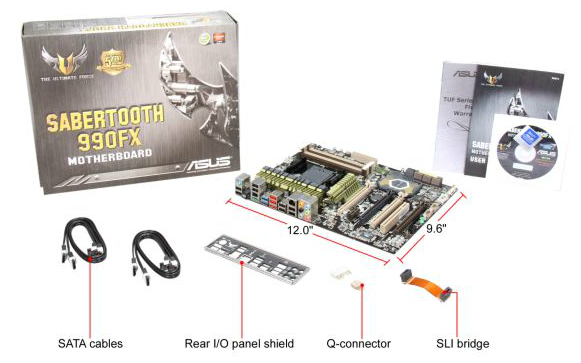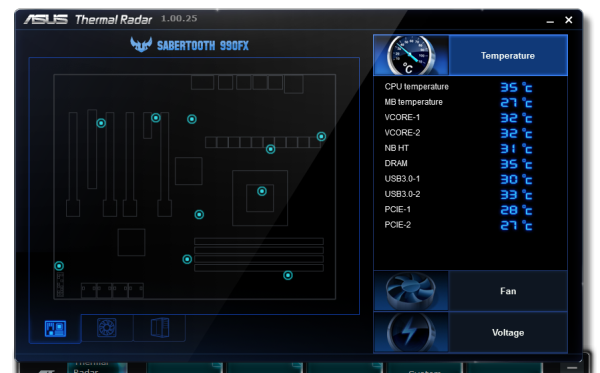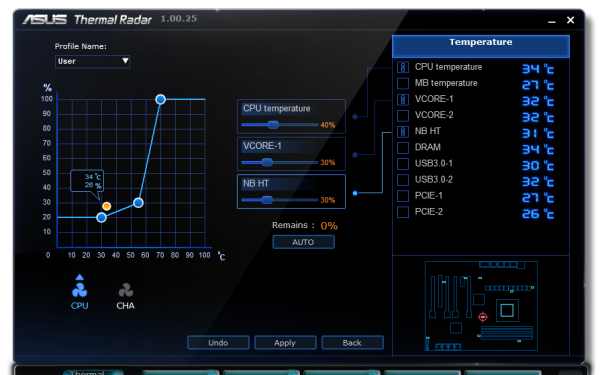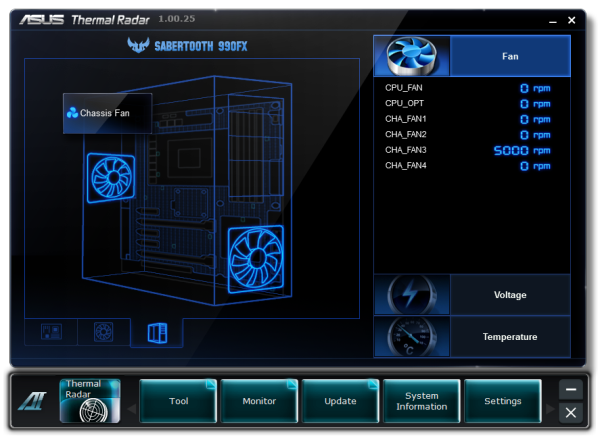990FX Motherboard Roundup with Thuban and Bulldozer – A Second Wind for ASUS, Gigabyte, MSI and Biostar
by Ian Cutress on April 5, 2012 11:00 AM ESTASUS Sabertooth 990FX In The Box
In comparison to the Crosshair V Formula, the Sabertooth does not come with as many goodies in the box. This may be indicative of the price difference (~$45 cheaper for the Sabertooth), and that part of the price of the Sabertooth is due to that five year warranty. In the box, we receive what I would deem the bare minimum for a product of this price:
IO Shield
Driver CD
User Guide
Four SATA Cables (Locking, right angled at one end)
Flexible SLI bridge
ASUS Q-Connector

Image Courtesy of Newegg
Board Features
| ASUS Sabertooth 990FX | |
| Price | Link to Newegg |
| Size | ATX |
| CPU Interface | AM3+ |
| CPU Support | AMD FX/Phenom II/Athlon II/Sempron 100 |
| Chipset | AMD 990FX |
| Base Clock Frequency | 200.66 MHz |
| Core Voltage | Auto, 0.675 V to 2.075 V |
| CPU Clock Multiplier | Auto, 4x to 35x |
| DRAM Voltage | Auto, 1.2 V to 2.5 V |
| DRAM Command Rate | Auto, 1T or 2T |
| Memory Slots |
Four DDR3 DIMM slots supporting up to 32 GB Up to Dual Channel Support for DDR3, 1066-1866 MHz, ECC or Non-ECC |
| Expansion Slots |
3 x PCIe Gen2 x16 (x16/x16 or x16/x8/x8) 1 x PCIe Gen2 x4 1 x PCIe Gen2 x1 1 x PCI |
| Onboard SATA/RAID |
6 x SATA 6 Gbps, Support for RAID 0, 1, 5, 10 2 x SATA 3 Gbps (JMicron JMB362) 1 x Power eSATA 3 Gbps 1 x eSATA 3 Gbps |
| Onboard |
6 x SATA 6 Gbps (Chipset) 2 x SATA 3 Gbps (JMicron JMB362) 6 x Fan Headers 2 x USB 2.0 Headers 1 x USB 3.0 Headers 1 x S/PDIF Output Header 1 x Front Panel Header 1 x COM Port Header 1 x Clear CMOS Header 1 x IEEE1394 Header 1 x MemOK! Button |
| Onboard LAN | Realtek 8111E |
| Onboard Audio | Realtek ALC892 |
| Power Connectors |
1 x 24-pin ATX connector 1 x 8-pin 12V connector |
| Fan Headers |
1 x CPU Fan Header (4-pin) 4 x CHA Fan Headers (one 4-pin, three 3-pin) 1 x OPT Fan Headers (4-pin) |
| IO Panel |
1 x Keyboard/Mouse PS2 Port 1 x Power eSATA 3 Gbps 1 x eSATA 3 Gbps 1 x IEEE1394 Port 1 x Gigabit Ethernet 2 x USB 3.0 10 x USB 2.0 1 x Optical SPDIF Output Audio Outputs |
| BIOS Version | 0901 |
| Warranty Period | 5 Years |
Instead of bleating continuously about that five year warranty, on the board we have a set of six fan connectors, and the SATA ports are bolstered by a SATA 6 Gbps controller in the form of the rarely seen JMicron JMB362. Lacking on the Sabertooth products are the Power/Reset buttons and two-digit debug LED which is unfortunate, plus there is extra space on the back panel for perhaps an extra network controller. The board uses also a Realtek NIC/Audio combination.
Software
ASUS Software revolves around its AI Suite package. This attempts to bring together all the features of the product into one interface, which for the most part is simple enough to use. One downside of the AI Suite software is on the DPC Latency, our audio test. This test performs a deferred procedure call and times how long it takes the system to process it – these calls are queued based on priority. The DP calls done by AI Suite as part of its sensor software have higher priority than audio, thus causing the DPC Latency to increase from ~200 microseconds (sub-500 is a good result), to over 2000 microseconds. Ideally this means that if you are expecting to record audio with an ASUS system, AI Suite should be switched off. I should note that other manufacturers are victims of this also – any vendor that includes sensor software as part of its package and by default causes it to boot with the operating system is liable to these spikes in performance for the DPC Latency test.
With that being said, AI Suite is good at what it does. As this is a Sabertooth product, we get Sabertooth specific features. Instead of the AI Tuner we normally get on an ASUS product, this is replaced by the Thermal Radar:
This integrated fan technology allows the user to associate fans connected on the board to certain temperature sensors. So a chassis fan at the back of the case directed air in or out can be connected to the CPU and VRM sensors (at a ratio determined by the user), and have its speed adjust appropriately using a customized multi-ramp speed profile. If you wanted customizability with your fans, ASUS has got it with their Sabertooth product.
Elsewhere on the AI Suite software is the TurboV Evo option, allowing the user to apply temporary overclocks until the system is restarted, and Digi+ VRM, giving the user control over the limitations of the power delivery on board (applicable to overclocked systems). AI Charger as part of the AI Suite gives extra current to a particular header on the motherboard, allowing it to charge your Apple device (iPod, iPhone or iPad) at a faster rate. Users can also update the BIOS through the AI Suite software.



















57 Comments
View All Comments
fredisdead - Saturday, April 7, 2012 - link
The design of bulldozer/ interlagos is aimed at the server market, where it has absolutely smoked intel the last few months.That said, these are suspiciously skewed benchmarks. Have a look here for a better representation of how bulldozer really performs.
http://www.phoronix.com/scan.php?page=article&...
It's pretty simple really, AMD used the chip real estate to double the number of cores, vs using it on less, but more powerful cores. Seeing that a single bulldozer core appears to have about 80% of the performance of an intel i5 core, looks like a good trade off. For highly threaded applications, its a complete win, and they are doing it on less advanced geometry.
That said, AMD's main product in the consumer space isn't bulldozer, it's llano, and thats looking like a rather large success too.
Oscarcharliezulu - Saturday, April 7, 2012 - link
Nicely written review Ian, was a pleasure to read. I like to hear subjective impressions as well as the facts and figures.Looking at an upgrade I thought to support AMD this time around. The boards seem very well featured for the price compared to intel (though they are catching up) and provide good sata3 and USB support. The problem is the BD cpu's run hot, slow and old software won't run well on it compared to older thubans.
My question- is AMD looking to provide support for more than 4 dimm sockets so we can run large amounts of ram in the future?
quanta - Tuesday, April 10, 2012 - link
Ironically, the A70M/A75 'Hudson' chips, which are designed for the non-FX CPU, actually has built-in USB 3 support that even SB950 doesn't have! The 9-series is supposed to be the enthusiast choice, how can AMD dropped the ball even BEFORE it can pick it up? Compare to the CPU that AMD has designed and built, the I/O support chip design is simple, yet AMD can't even get USB 3.0 and PCI Express 3 to at least relieving some performance bottleneck. If AMD can't even get the chip set right, there is no way in silicon hell for AMD to keep its dwindling fan base, at ANY price/performance bracket.primonatron - Thursday, April 12, 2012 - link
That audio chip on the ASUS ROG motherboard IS a Realtek one. They just allow the installation of a X-Fi utility on top for sound effects.You can see the realtek drivers are required on the ASUS website, but an X-Fi utility is also provided.
Marketing hogwash. :(
http://www.asus.com/Motherboards/AMD_AM3Plus/Cross...
cocoviper - Thursday, April 19, 2012 - link
I'm not defining $240 as the limit for Enthusiast CPUs, I'm saying AMD doesn't have any CPUs that are competitive above that price-point.What the category is called is semantics. We could break the entire line into 100 different categories and it wouldn't change the fact that AMD doesn't have any consumer CPUs in the top 3/4 of the market.
I wasn't quoting Anand like he what he says is law or something, I was noting AMD's strategy day where getting out of the high end market was discussed.
Don't you believe AMD, and ultimately all of us as consumers are at a disadvantage if AMD's best product is capped at $250 or so, leaving $250-up-to-however much Intel wants to charge all their domain? How would you feel if the Radeon series only had products in the lower 25% of the $0-$700 Videocard market? Does the best Radeon being capped at $175 seem like it would keep Nvidia competitive in performance and price?
cocoviper - Thursday, April 19, 2012 - link
Isn't arguing about what price-point defines enthusiast the very definition of semantics? Why don't we just make all processors enthusiast, regardless of price. There AMD and Intel now both make enthusiast processors.To return to the point, Intel's enthusiast processors are the only ones occupying the top 3/4 of the market in cost to end customers. Cost is determined by the market; what people will and will not buy. This is why AMD just announced a price cut on the 7000 series to account for the Kepler launch. Competitive performance and prices keep all suppliers in the market in check, and the end consumer benefits.
The point is AMD is ceding the top 3/4 of the market, and even if they make $200 "enthusiast" processors, Intel is free to charge whatever they like to people that need or want high-end performance. This is bad for all of us, and lame on AMD's part.
menlg21p - Wednesday, March 20, 2013 - link
I made a mistake of installing network genie, and it doesn't show up in my programs and features. I cannot uninstall this program. There is no option for execution on startup. So it always starts up on boot. And there is nothing in the directories that pertain to uninstall. Also no online-content about this feature. Ugh, MSI, what are you doing? Why did you suggest this "crap" on my driver disk. REALLY?